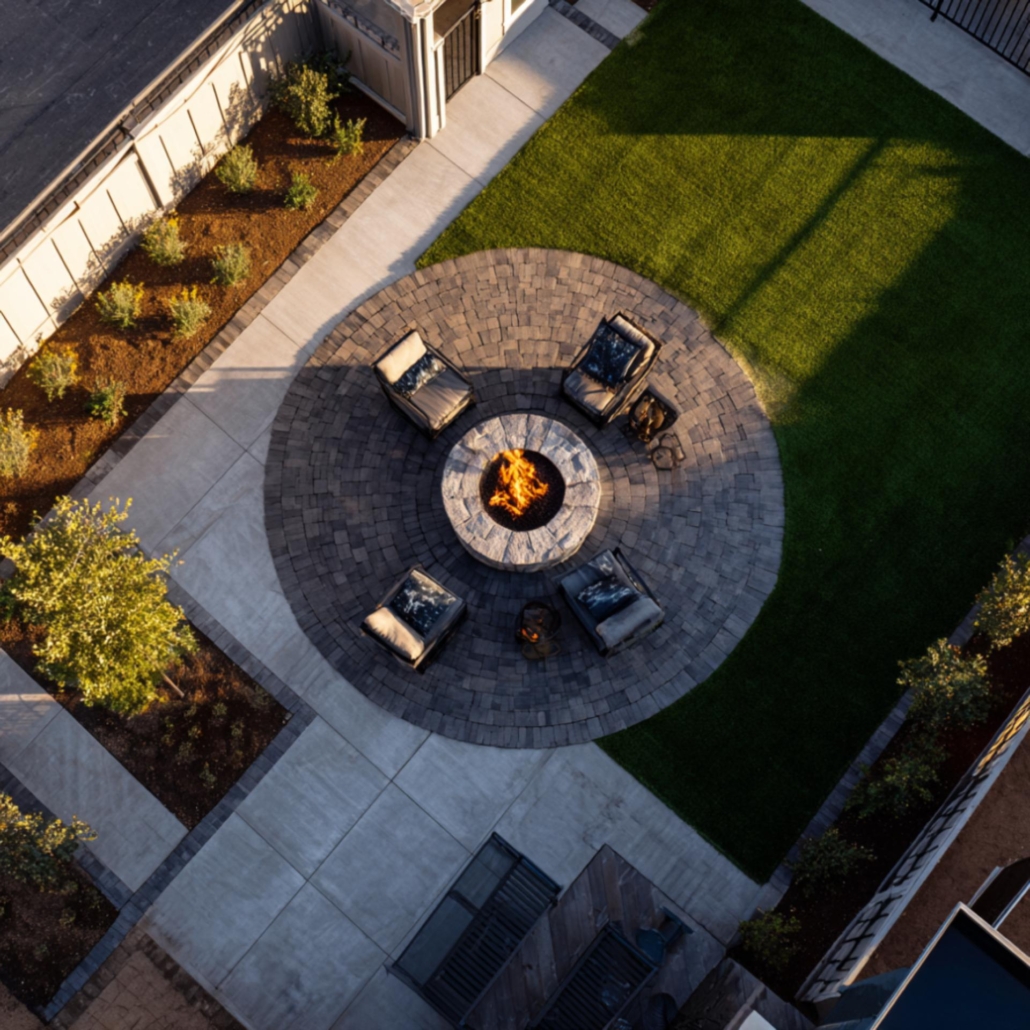Firepit on Grass: Is Artificial Grass Flammable and How to Stay Safe?


There’s an undeniable magic to a backyard fire pit, the gravitational center for good conversation and questionable S’more-making techniques. But when your outdoor space is a flawless, emerald-green lawn, putting a fire pit on grass feels like a dare. Can you have both, or are you just asking for a melted, scorched mess?
The dream of a glowing firepit on grass dies fast on a classic lawn. Placing a fire pit directly on natural grass is a fantastic way to kill it. The intense heat scorches the blades and sterilizes the soil underneath, leaving a permanent, ugly brown patch. Worse, if the grass is dry, stray embers can easily ignite it.

The answer here is a hard no, with a strategic yes attached. You absolutely cannot place a fire pit directly onto your artificial turf. The heat will destroy the synthetic fibers instantly. However, you can safely have a fire pit within your artificial grass landscape. The key is creating a designated, heatproof stage for your fire feature that isolates it completely from the turf itself.
Before you even buy a fire pit, play detective. Fire safety is governed by local ordinances and, often, HOA rules. Most cities and counties have strict regulations dictating how far a fire pit must be from any structure, like your house or a fence. While some guidelines suggest a minimum of 10 feet, fire safety experts often recommend a safer distance of at least 20 to 25 feet to prevent heat damage or fire from stray sparks. Always check with your local fire department for the specific codes in your area, which is a frequent concern for homeowners considering artificial grass in San Diego and other arid climates. Don’t assume; verify.
Here’s the critical distinction: modern, high-quality artificial grass is designed to be fire-retardant, not flammable. So, is artificial grass flammable like a piece of paper? No. It won’t ignite and spread flames because manufacturers treat the materials to resist fire, often achieving a Class 1 fire rating.
However, direct contact with a hot ember or intense radiant heat will cause the synthetic fibers to melt. Damage can occur at temperatures as low as 175-200°F, especially from the radiant heat of a fire pit or focused reflections. A hot coal will cause the plastic fibers to fuse together, creating permanent aesthetic damage. Even the most durable artificial grass for landscaping will suffer this fate. The answer to “is artificial grass flammable?” is no, but the risk of ugly, melted scars is very real.
Placing a fire pit on grass without any protection is courting disaster, whether the grass is real or not. The dangers are distinct but equally problematic.
You can have that perfect backyard fire pit experience without the risk. It’s all about creating layers of safety and thinking like a firefighter.
Your responsibility doesn’t end when the last marshmallow is toasted.
Having a fire pit on grass—especially the artificial kind—is entirely possible. It just requires smart planning and a healthy respect for what happens when intense heat meets modern materials. By creating a dedicated, fireproof zone and following basic safety rules, you can enjoy the magic of a backyard fire without ever having to worry about a melted, messy aftermath.
Back Nine Greens. (2017). Safety Tips for Artificial Grass and Fire pits. Back Nine Greens. https://backninegreens.com/blog/safety-tips-for-artificial-grass-and-fire-pits/
Lincoln Park Fire Department. (n.d.). Fire Pit Safety. City of Lincoln Park, Michigan. https://www.citylp.com/departments/fire_department/fire_pit_safety.php
Merchants Insurance Group. (2022). Guidelines for Fire Pit Safety. Merchants Insurance Group. https://www.merchantsgroup.com/blog/guidelines-for-fire-pit-safety-this-summer/
National Fire Protection Association. (2020). NFPA Educational Messages Desk Reference for the Fire Service and Fire and Life Safety Educators. National Fire Protection Association. https://www.newhaven.edu/_resources/documents/about/public-safety/fire-policies/NFPA-Fire-Safety.pdf
Vaglica, S. (2025). All About Fire Pits. This Old House. https://www.thisoldhouse.com/yards/21019098/all-about-fire-pits
Wagner, M. (2025). Is Artificial Grass Flammable? A Complete Guide to Fire Safety and Synthetic Turf. SYNLawn. https://www.synlawn.com/resources/is-artificial-grass-flammable-a-complete-guide-to-fire-safety-and-synthetic-turf/
Walden Backyards. (2024). Wood Burning Fire Pit Dos and Don’ts. Walden Backyards. https://www.waldenbackyards.com/blogs/about-fire-pits/fire-pit-dos-and-donts

Festival Turf
Phone: 844-702-8873
Email: [email protected]
Las Vegas HQ Hours
Monday-Friday: 8:00am – 4:00pm PST
Saturday: 8:00am – 12:00pm
Sunday: CLOSED
Have a Question?
Contact us now and we’ll help you find what you need!

 Why Pet‑Friendly Artificial Grass Is a Smart Choice for Your Home and Pet...
Why Pet‑Friendly Artificial Grass Is a Smart Choice for Your Home and Pet...